Hotel Housekeeping
On this page
- What kind of work do people do in housekeeping in a hotel?
- What are the risk factors of housekeeping?
- How can we reduce the risk factors for
repetitive motion injuries (RMIs) ? - How can job rotation reduce the risk for RMIs?
- How can job enlargement and enrichment reduce the risk for RMIs?
- How can team work reduce the risk for RMIs?
- How can improved work practices reduce the risk for RMIs?
- What other hazards are hotel housekeepers exposed to?
- What are some preventive measures for a hotel housekeeper?
- What are some good general safe work practices?
What kind of work do people do in housekeeping in a hotel?
Back to topHousekeeping in a hotel is a very physically demanding job that includes many, varied tasks.
NOTE: This document discusses the health and safety aspects of hotel housekeeping involving repetitive motion injuries (RMIs). If you are seeking a job in housekeeping, it is recommended that you contact the organization you wish to work for directly. Some job offers are available through services such as Job Bank Canada.
Based on a case study, housekeepers were typically responsible for cleaning 16 rooms per shift. The actual amount of work depends on the size of the room and the number of beds. A housekeeper needs between fifteen and thirty minutes to do one room. A housekeeper carries out the following tasks:
- making beds (Figures 1a, 1b, 1c)
- tidying rooms (Figure 2)
- cleaning and polishing toilets, taps, sinks, bathtubs and mirrors (Figures 3a, 3b)
- washing floors
- removing stains
- vacuuming
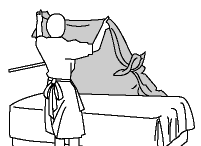
Figure 1a - Making Beds
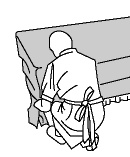
Figure 1b - Making Beds
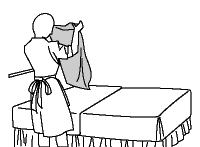
Figure 1c - Making Beds
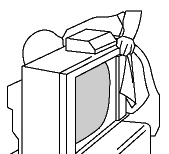
Figure 2 - Tidying a room
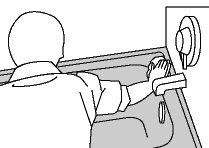
Figure 3a - Cleaning
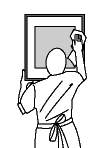
Figure 3b- Cleaning
What are the risk factors of housekeeping?
Back to topThe main risk factors for repetitive motion injuries (RMIs) in housekeeping are:
- heavy physical workload and excessive bodily motions which are a high risk for back injuries
- forceful upper limb motions in awkward positions which are a high risk for neck or shoulder and arm injuries
Space limitations require workers to use many uncomfortable postures. These are:
- standing or walking
- stooping
- squatting
- kneeling
- stretching
- reaching
- bending
- twisting
- crouching
A housekeeper changes body position every three seconds while cleaning a room. If we assume that the average cleaning time for each room is twenty-five minutes, we can estimate that a housekeeper assumes 8,000 different body postures every shift.
In addition, forceful movements while using awkward body positions include lifting mattresses, cleaning tiles, and vacuuming every shift. Housekeeping is a physically demanding and very tiring job. It can be classified as "moderately heavy" to "heavy" work because the energy required is approximately 4 kilocalories per minute (4kcal/min).
How can we reduce the risk factors for
Back to top
Hotel housekeepers work in a unique place. Hotels are usually designed for the comfort of their guests rather than their housekeeping staff. This fact makes it very difficult to improve working conditions for housekeepers by means of better engineering. However, some improvements can be made by selecting more appropriate equipment.
Lighter vacuum cleaners (preferably the self-propelling type), and lighter service carts with wheels designed for carpeted floors would ease the workload for their operators providing this equipment is always kept in good repair. When new vacuum cleaners are purchased, low noise emissions should be one of the criteria.
Improving the body postures that pose a major risk for musculoskeletal disorders seems an unachievable task. Again, this fact results from the peculiarity of hotels as a workplace. To attract guests and remain competitive, hotel management pursues a policy that everything should be "so clean it sparkles". Floors, walls, windows, mirrors, and bathroom fixtures might be adequately cleaned with some form of an extension tool to reduce bending and over-stretching. However, the demand for spotless cleanliness and hygiene, management often requires their cleaning staff to spend extra time and effort cleaning by kneeling, leaning, squatting, crouching, slouching and stretching. These postures will, in time, contribute to new musculoskeletal injuries and aggravate old ones.
New approaches, other than strictly ergonomic ones, need to be investigated. For example, action can be taken from the administrative level. Options for improvement include:
- job rotation
- job enrichment and job enlargement
- team work
- education and training on work practices
How can job rotation reduce the risk for RMIs?
Back to topJob rotation is one possible approach. It requires workers to move between different tasks, at fixed or irregular periods. However, it must be a rotation where workers do something completely different. Different tasks must use different muscle groups to allow muscles already stressed to recover.
How can job enlargement and enrichment reduce the risk for RMIs?
Back to topAnother approach is job enlargement. This approach increases the variety of tasks built into the job. It breaks the monotony of the job and avoids overloading one part of the body. Job enrichment involves more autonomy and control for the worker.
How can team work reduce the risk for RMIs?
Back to topTeam work can provide greater variety and more evenly distributed muscular work. The whole team is involved in the planning of the work. Each team member carries out a set of operations to complete the whole product, allowing the worker to alternate between tasks. This approach reduces the risk of RMI.
How can improved work practices reduce the risk for RMIs?
Back to topA well-designed job, supported by a well-designed workplace and proper tools, allows the worker to avoid unnecessary motion of the neck, shoulders and upper limbs. However, the actual performance of the tasks depends on individuals.
Training should be provided for workers who are involved with housekeeping activities. It is important that housekeeping staff be informed about hazards in the workplace, including the risk of injuries to the musculoskeletal system. Therefore, identification of the hazards for such injury at any given hotel is fundamental.
Individual work practices, including lifting habits, are shaped by proper training. Training should encourage employers and workers to adopt methods that reduce fatigue. For example, it is advisable to plan one's workload and do the heavier tasks at the beginning of the workshift, rather than at the end, when fatigue is at its maximum. When a person is tired, the risk of injuring a muscle is higher.
Training should also explain the health hazards of improper lifting and give recommendations on what a worker can do to improve lifting positions. Training should also emphasize the importance of rest periods for the workers' health and explain how active rest can do more for keeping workers healthy than passive rest. The effect of such training can reach far beyond occupational situations because the workers can apply this knowledge also in their off-job activities.
What other hazards are hotel housekeepers exposed to?
Back to topIn additional to the ergonomic hazards, hotel housekeepers are exposed to chemical, biological and physical hazards including:
- Exposure to chemicals in cleaning products, including skin reactions or respiratory illnesses.
- Exposure to biological infectious diseases from soiled linens, uncapped needles and/or bodily fluids.
- Slips, trips and falls.
- Fatigue and other health problems from shift work or long hours of work.
- Working alone.
- Workplace violence.
- Manual handling of equipment - vacuums, carts.
What are some preventive measures for a hotel housekeeper?
Back to top- Know potential hazards of your workplace and the activities you perform.
- Learn and use safe lifting techniques.
- Wear proper protective equipment when handling cleaning products.
- Wash your hands frequently -- an important step in preventing infection.
- Always wear appropriate personal protective equipment for the task.
- Wear shoes with non-skid soles.
- Know emergency contact numbers and keep them immediately available.
- Keep carts in good repair, check wheels and weight distribution of supplies.
- Use long handled tools such as dusters and mops to avoid bending and stretching.
- Review safety data sheet (SDS) for cleaning products and follow instructions for safe use and storage.
- Provide training on bloodborne pathogens and practices to follow if needles or bodily fluids are encountered in the hotel room. Have a sharps disposal container on the cart for needles and sharps.
What are some good general safe work practices?
Back to top- Practice safe lifting techniques.
- Follow or establish safety procedures for working alone, or for avoiding working alone wherever possible.
- Get current training on chemical hazards, WHMIS and SDSs.
- Know basic and emergency first aid.
- Follow company safety rules.
- Know how to report hazards.
- Practice good housekeeping procedures.
- Follow routine practices when handling linens and towels.
- Alternate arms when performing manual tasks.
- Take scheduled breaks and stretch breaks as necessary.
Acknowledgement
The Canadian Centre for Occupational Health and Safety in cooperation with the Government of Newfoundland and Labrador, Department of Employment and Labour Relations, Occupational Health and Safety Branch would like to acknowledge the participation of the staff at the Hotel Newfoundland (a Canadian Pacific Hotel) who so freely gave their time and resources to assist us in the development of this case study. This case study was organized to examine repetitive motion injuries.
- Fact sheet confirmed current: 2025-01-21
- Fact sheet last revised: 2020-01-02

